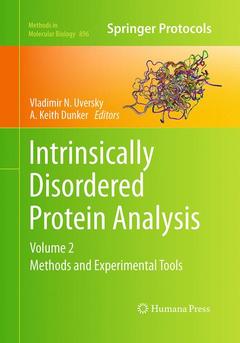Description
Intrinsically Disordered Protein Analysis, 2012
Volume 2, Methods and Experimental Tools
Methods in Molecular Biology Series, Vol. 896
Language: English
Subject for Intrinsically Disordered Protein Analysis:
Publication date: 08-2016
Support: Print on demand
Publication date: 07-2012
454 p. · 17.8x25.4 cm · Paperback
Description
/li>Contents
/li>Comment
/li>
Over the past decade, there has been an explosive development of research of intrinsically disordered proteins (IDPs), which are also known as unfolded proteins. Structural biologists now recognize that the functional diversity provided by disordered regions complements the functional repertoire of ordered protein regions. In Intrinsically Disordered Protein Analysis: Methods and Experimental Tools, expert researchers explorethe high abundance of IDPs in various organisms, their unique structural features, numerous functions, and crucial associations with different diseases. Volume 2 includes sections on single molecule techniques, methods to assess protein size and shape, analyzing conformational behavior, mass-spectrometry, expression and purification of IDP?s. Written in the highly successful Methods in Molecular Biology? series format, the chapters include the kind of detailed description and implementation advice that is crucial for getting optimal results in the laboratory.
Thorough and intuitive,Intrinsically Disordered Protein Analysis: Methods and Experimental Tools helps scientists further their investigations of these fascinating and dynamic molecules.
Immobilization of Proteins for Single Molecule Fluorescence Resonance Energy Transfer Measurements of Conformation and Dynamics.-Application of Confocal Single Molecule FRET to Intrinsically Disordered Proteins.-Single-Molecule Force Spectroscopy of Chimeric Polyprotein Constructs Containing Intrinsically Disordered Domains.-Visualization of Mobility by Atomic Force Microscopy.-Unequivocal Single-Molecule Force Spectroscopy of Intrinsically Disordered Proteins.-Sedimentation Velocity Analytical Ultracentrifugation for Intrinsically Disordered Proteins.-Analysis of Intrinsically Disordered Proteins by Small-Angle X-ray Scattering.-Small Angle Neutron Scattering (SANS) for the Structural Study of Intrinsically Disordered Proteins in Solution: a Practical Guide.-Dynamic and Static Light Scattering of Intrinsically Disordered Proteins.-Estimation of Intrinsically Disordered Protein Shape and Time-averaged Apparent Hydration in Native Conditions by a Combination of Hydrodynamic Methods.-Size-Exclusion Chromatography in Structural Analysis of Intrinsically Disordered Proteins.-Denaturant-induced Conformational Transitions in Intrinsically Disordered Proteins.-Identification of Intrinsically Disordered Proteins by a Special 2D Electrophoresis.-pH-induced Changes in Intrinsically-disordered Proteins.-Temperature Induced Transitions in Disordered Proteins Probed by NMR Spectroscopy.-Analyzing Temperature Induced Transitions in Disordered Proteins by NMR Spectroscopy and Secondary Chemical Shift Analyses.-Osmolyte-, Binding-, and Temperature-Induced Transitions of Intrinsically Disordered Proteins.-Laser Temperature-jump Spectroscopy of Intrinsically Disordered Proteins.-Differential Scanning Microcalorimetry of Intrinsically Disordered Proteins.-Identifying Disordered Regions in Proteins by Limited Proteolysis.-The Effect of Counter Ions on the Conformation of Intrinsically Disordered Proteins Studied by Size-exclusion Chromatography.-Mean Net Charge of Intrinsically Disordered Proteins: Experimental Determination of Protein Valence by Electrophoretic Mobility Measurements.-Protein Characterization by Partitioning in Aqueous Two-Phase Systems.-Detection and Characterization of Large-scale Protein Conformational Transitions in Solution using Charge-state Distribution Analysis in ESI-MS.-Localizing Flexible Regions in Proteins using Hydrogen Deuterium Exchange Mass Spectrometry.-Mass-spectrometry Tools for Analysis of Intermolecular Interactions.-Characterization of Oligomerization- Aggregation Products of Neurodegenerative Target Proteins by Ion Mobility Mass Spectrometry.-Identifying Solubility-promoting Buffers for Intrinsically Disordered Proteins Prior to Purification.-Proteomic Methods for the Identification of Intrinsically Disordered Proteins.-Selective Isotope Labeling of Recombinant Proteins in E. coli.
These books may interest you

Intrinsically Disordered Proteins 157.46 €



